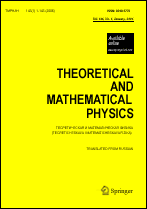|
Double-logarithmic asymptotics of scattering amplitudes in gravity and supergravity
L. N. Lipatov
Petersburg Nuclear Physics Institute, Gatchina,
St. Petersburg, Russia
Abstract:
We review the Balitsky–Fadin–Kuraev–Lipatov approach to high-energy scattering in QCD and supersymmetric gauge theories. At a large number of colors, the equations for the gluon composite states in the $t$-channel have remarkable mathematical properties including their Möbius invariance, holomorphic separability, duality symmetry, and integrability. We formulate a theory of Reggeized gluon interactions in the form of a gauge-invariant effective action local in particle rapidities. In the maximally extended $N=4$ supersymmetry, the Pomeron is dual to the Reggeized graviton in the ten-dimensional anti-de Sitter space. As a result, the Gribov Pomeron calculus should be reformulated here as a generally covariant effective field theory for the Reggeized gravitons. We construct the corresponding effective action, which allows calculating the graviton Regge trajectory and its couplings. We sum the double-logarithmic contributions for amplitudes with graviton quantum numbers in the $t$-channel in the Einstein–Hilbert gravity and its supersymmetric generalizations. As the supergravity rank $N$ increases, the double-logarithmic amplitudes begin to decrease rapidly compared with their Born contributions.
Keywords:
quantum gravity, high-energy asymptotic behavior, behavior of Regge-type amplitudes, double-logarithmic approximation.
Citation:
L. N. Lipatov, “Double-logarithmic asymptotics of scattering amplitudes in gravity and supergravity”, TMF, 175:3 (2013), 408–418; Theoret. and Math. Phys., 175:3 (2013), 788–796
Linking options:
https://www.mathnet.ru/eng/tmf8489https://doi.org/10.4213/tmf8489 https://www.mathnet.ru/eng/tmf/v175/i3/p408
|


|




 Contact us:
Contact us: Terms of Use
Terms of Use
 Registration to the website
Registration to the website Logotypes
Logotypes








 Citation in format
Citation in format 